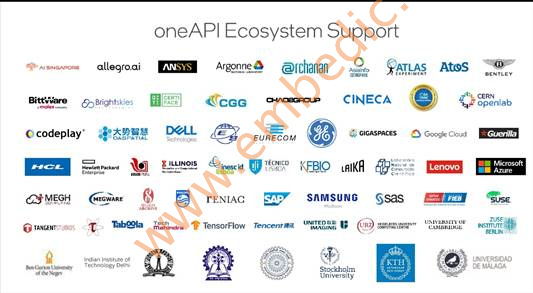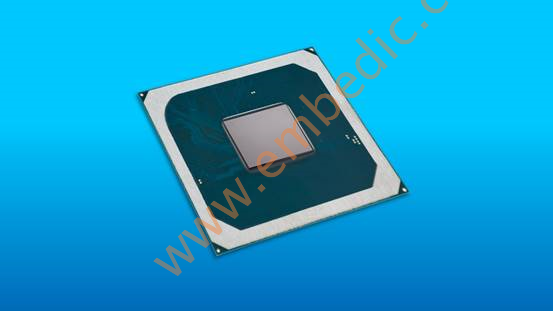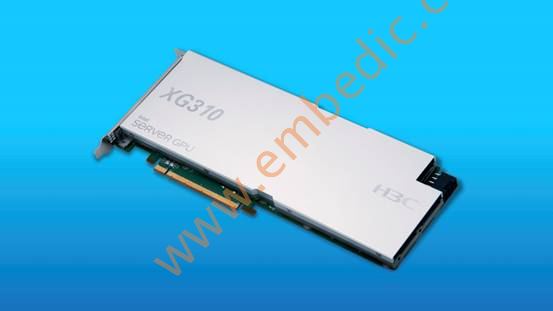Intel today announced a number of important technological developments, which is another milestone in Intel's efforts to create cross-architecture solutions through a unified software experience for many years. Among them, the Intel® oneAPI Gold toolkit will be officially delivered in December this year; Intel software stack introduces new functions as part of the company's software and hardware joint design method. At the same time, Intel officially released its first discrete graphics card for data centers. The server GPU is based on the Xe-LP micro-architecture and is designed for high-density, low-latency Android cloud gaming and streaming services.
Raja Koduri, Intel’s senior vice president, chief architect and general manager of the architecture, graphics and software division, said: “Today is an important moment for Intel’s oneAPI and XPU grand plans. With the release of the oneAPI Gold version, developers’ programming experience will be more enriched. oneAPI not only has CPU programming libraries and tools familiar to developers, but also includes programming libraries and tools with a hybrid architecture of scalar-vector-space. At the same time, we also launched the first data center GPU based on the Xe-LP micro-architecture. Meet the rapidly growing market demand for cloud games and streaming media."
Importance: As the world enters the era of billions of smart devices, data is growing exponentially, and it is necessary to shift the focus from a single CPU to a hybrid architecture that spans CPU, GPU, FPGA, and other accelerators. Intel calls it " XPU" vision. The launch of Intel® server GPUs is the latest step in Intel's expansion of its product portfolio in the XPU era.
This computing era also requires a comprehensive software stack. Through the Intel oneAPI toolkit, developers can access Intel XPU using a common, open and industry-standard programming model. This not only releases the performance potential of the underlying hardware, but also reduces software development and maintenance costs. In terms of deploying accelerated computing, the Intel® oneAPI toolkit is less risky than a dedicated solution that is restricted to a specific vendor.
Intel launches the oneAPI Gold toolkit: Intel’s oneAPI industry plan was first proposed at the SuperComputing 2019 conference. This is Intel’s vision for a unified and simplified cross-architecture programming model: to provide uncompromising performance, not limited to a single Manufacturer-specific code restrictions, and can realize the integration of the original code. With oneAPI, developers can choose the best accelerator architecture for the specific problem they want to solve without having to rewrite the software for the new architecture and platform.
The Intel oneAPI toolkit takes full advantage of advanced hardware performance and instructions, such as Intel® AVX-512 (Advanced Vector Extensions) and Intel® Deep Learning Boost (Intel® DL Boost) for CPUs, as well as XPU unique features. The oneAPI toolkit is based on the long-tested Intel developer tools, providing developers with familiar programming languages and standards while maintaining complete continuity with existing code.
Today, Intel announced that the Intel oneAPI Gold toolkit will be freely available locally and on Intel DevCloud in December, and a commercial version with global support from Intel technical consulting engineers will also be provided. Intel will also migrate Intel® Parallel Studio XE and Intel® System Studio tool suite to oneAPI products.
In addition, the Intel DevCloud platform allows developers to test code and workloads on various Intel architectures, and new Intel® Iris® Xe GPU hardware has been added. Intel Iris Xe MAX graphics cards are now also available for public access; at the same time, Intel Xe-HP has been opened to specific developers.
OneAPI has been supported by the industry. Recently, Microsoft Azure and Google's TensorFlow have announced support for oneAPI; many leading research institutions, companies and universities also support oneAPI.

Legend: oneAPI ecological partner
In addition, the Beckman Institute for Advanced Science and Technology at the University of Illinois at Urbana-Champaign announced today that it will establish a new oneAPI Center of Excellence (CoE). They are using the oneAPI programming model to extend the life science application NAMD to other computing environments. NAMD can simulate large-scale biomolecular systems and is helping to solve global challenges such as COVID-19. This center of excellence will work with the Stockholm University (SERC) Center of Excellence for GROMACS and the Center of Excellence at Heidelberg University (URZ) to jointly study how to provide oneAPI support for GPUs from other manufacturers.
Regarding Intel’s new server GPU: Intel has further expanded its rich platform-level innovations in enhancing cloud gaming and media experience through its first dedicated display product for data centers. Utilizing the combination of Intel® Xeon® Scalable processor and the new Intel server GPU, together with the open source and licensed Intel software components, that can lower the total cost of ownership (TCO)1, for Android cloud games and OTT real-time video broadcast High-density media transcoding provides high-density, low-latency solutions.
Intel server GPUs use Intel’s most energy-efficient graphics architecture-Intel Xe-LP microarchitecture, with low power consumption, independent system-on-chip design, and equipped with a 128-bit pipeline and 8GB dedicated onboard low-power DDR4 video memory.

Legend: Intel Server GPU
By combining Intel server GPUs and Intel® Xeon® Scalable processors, service providers can independently expand the graphics card capacity without changing the number of servers to support more streams and subscribers on each system , And at the same time achieve a lower total cost of ownership (TCO). Through the Xin H3C XG310 X16 PCIe3.0 GPU expansion card-encapsulating four Intel server GPU chips in a 3/4-length, full-height size, it can support more than 100 concurrent users of Android cloud games in a typical dual-card system. This number can be expanded up to 160 concurrent users, and the actual number depends on the specific game and server configuration2. Developers can use the common API in the current Media SDK, which will also be migrated to the oneAPI video processing library next year. Currently, Intel is cooperating with many software and service partners including Gamestream, Tencent and Ubitus to jointly bring Intel server GPUs to the market.

Legend: Xinhua Three XG310 PCIe GPU Expansion Card
Fang Liang, Assistant General Manager of Tencent Xianyou Cloud Games, said: “Intel is a very important partner in our Android cloud gaming solutions. Intel Xeon Scalable processors and Intel server GPUs have created a high-density, low-latency, The low-power, low-TCO solution allows us to generate more than 100 game instances on each dual-card server, such as "Glory of the King" and "Legend Showdown"."
Intel server GPUs based on the Xe-LP microarchitecture are currently shipping. Together with the recently launched Intel® Iris® Xe MAX unique display, this GPU will further enhance the visual computing experience for global users with the continuous development of Intel Xe architecture products and software plans.
Intel® Graphics Software Update: One of Intel’s core strategies to extend GPUs from entry-level graphics cards to high-performance computing (HPC) is to implement the same code base. To achieve this goal, Intel’s software stack now supports multiple generations of graphics cards, including the recently released 11th generation Intel® Core™ mobile processor integrated Iris Xe graphics and Intel Iris Xe MAX discrete graphics. Expanding the code base to support Linux's more common data center products is the next key step in the scalable Xe architecture strategy. Intel optimized the Linux driver, focused on code reuse between operating systems, and further focused on Linux 3D performance. Currently, it provides three fully validated and integrated release stacks.
Intel today announced that Intel has created Project Flipfast to enhance the gaming experience on the Linux operating system. The Flipfast stack allows end users to run graphics applications on virtual machines, while maintaining the native GPU performance and host integration through zero-copy sharing between the virtual machine and the host.
Intel also announced today that Intel® Implicit SPMD Program Compiler (ISPC) will run on top of the underlying hardware interface oneAPI Level Zero. OneAPI zero level is the entire hardware abstraction layer, which is tailored for the devices in the oneAPI platform and provides a low-level interface directly to the hardware. ISPC supported by oneAPI is a variant of the C programming language that supports single-program and multi-data programming and is used to accelerate the Intel® Osray ray tracing engine on Intel CPUs. Intel added Xe support to ISPC to seamlessly accelerate Intel oneAPI rendering toolkit components (such as Osray).
Next plan: From November 12th to 13th, at the oneAPI Developer Summit held online, innovators, researchers and developers will show 40 collaborations and projects that use oneAPI. Topics range from drug reuse testing for COVID-19 to crop yield forecasts. At SuperComputing 2020 starting this week, Intel and industry leaders and research institutions will focus on oneAPI applications and Intel oneAPI tools through keynote speeches, technical meetings, fireside conversations, demonstrations and other activities.
The update of Intel's oneAPI and graphics software stack, as well as the introduction of Intel server GPUs, mark Intel's milestone step towards the XPU architecture era. Based on Intel’s six technological pillar innovations and heterogeneous architecture, and realized through a unified and scalable software abstraction layer based on open standards in oneAPI, these advances have laid a solid foundation for a better experience.
1. The total cost of ownership (TCO) analysis is based on Intel's internal research. Prices as of October 1, 2020. The analysis assumes that standard server pricing, GPU list pricing, and software pricing are based on estimated Nvidia software license costs, which is $1 per year for 5 years.
2. Performance may vary depending on the specific game name and server configuration.
Manufacturer: Microchip
IC MCU 8BIT 28KB FLASH 64TQFP
Product Categories: 8bit MCU
Lifecycle:
RoHS:
Manufacturer: Texas Instruments
IC DIGITAL MEDIA SOC 529FCBGA
Product Categories: SOC
Lifecycle:
RoHS:
Manufacturer: Texas Instruments
IC DGTL MEDIA PROC 529FCBGA
Product Categories: DSP
Lifecycle:
RoHS:
Manufacturer: Texas Instruments
IC DSP FIXED POINT 169BGA
Product Categories: DSP
Lifecycle:
RoHS:
Looking forward to your comment
Comment